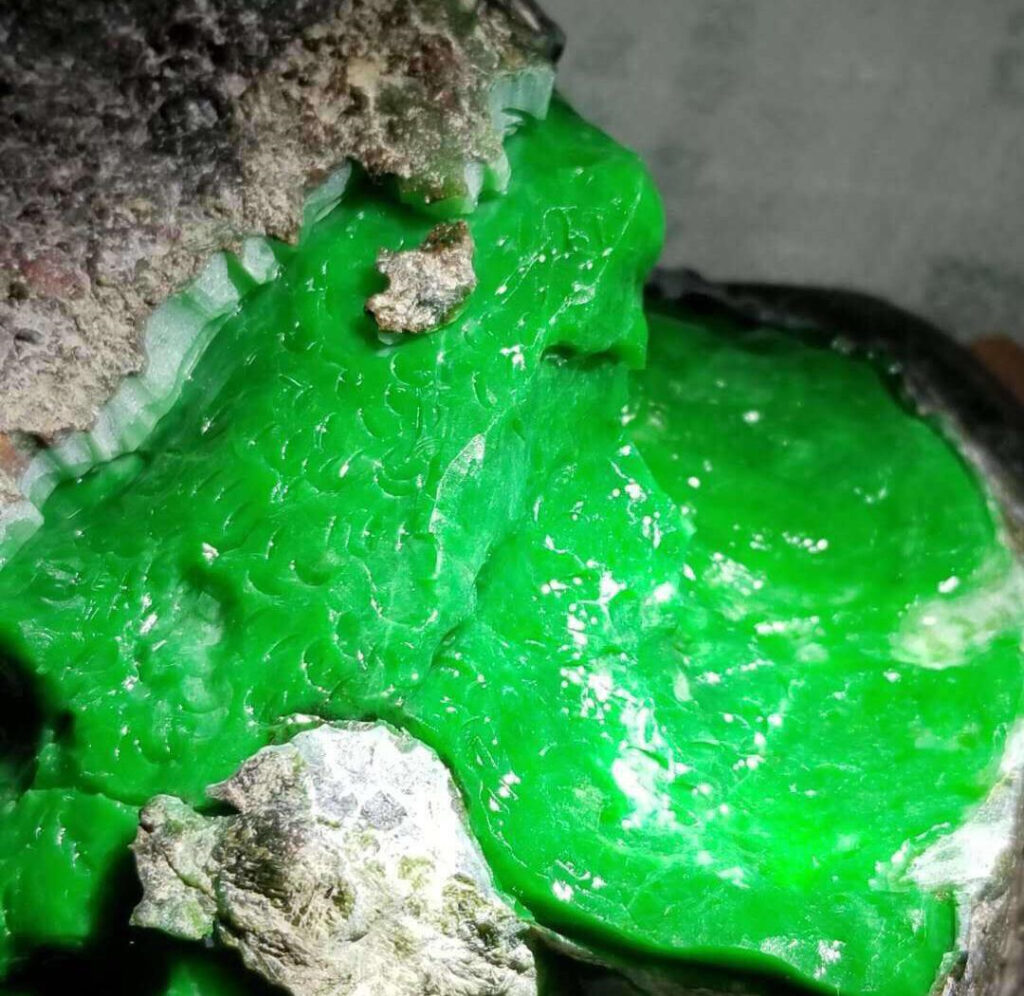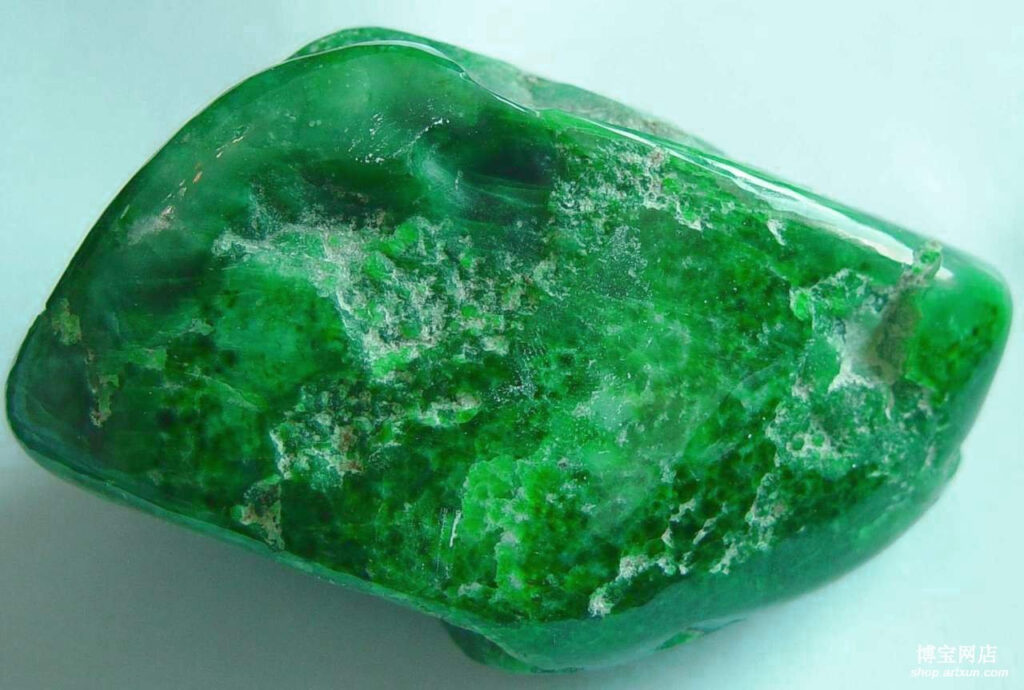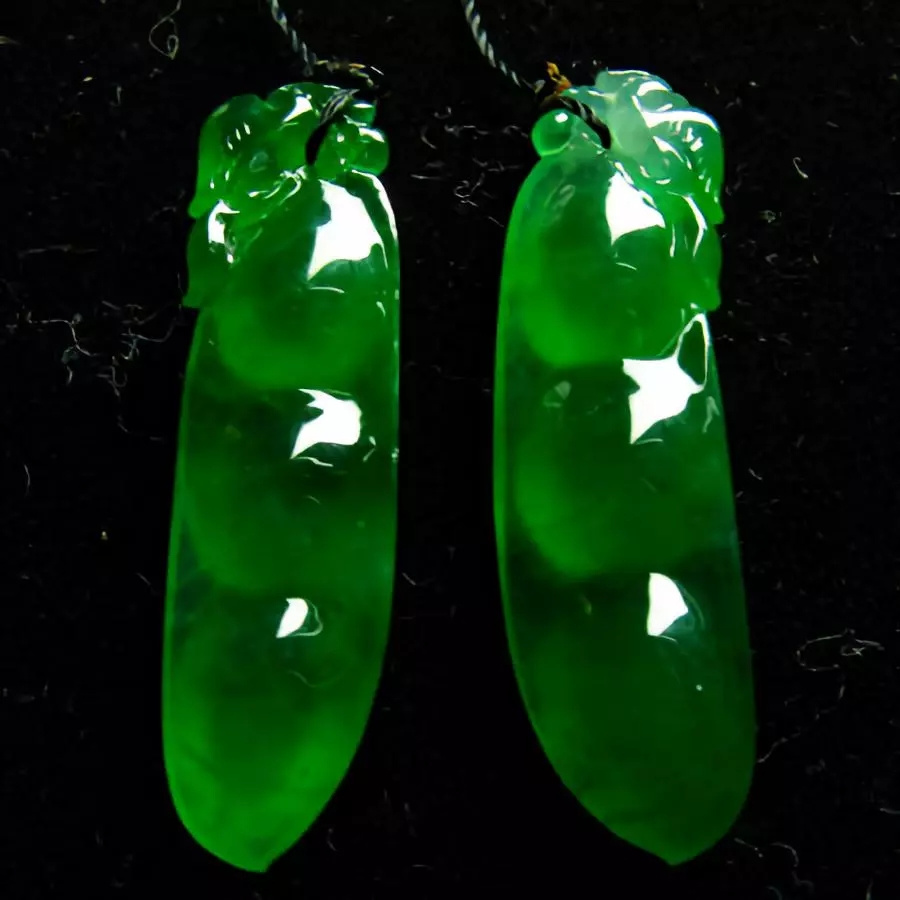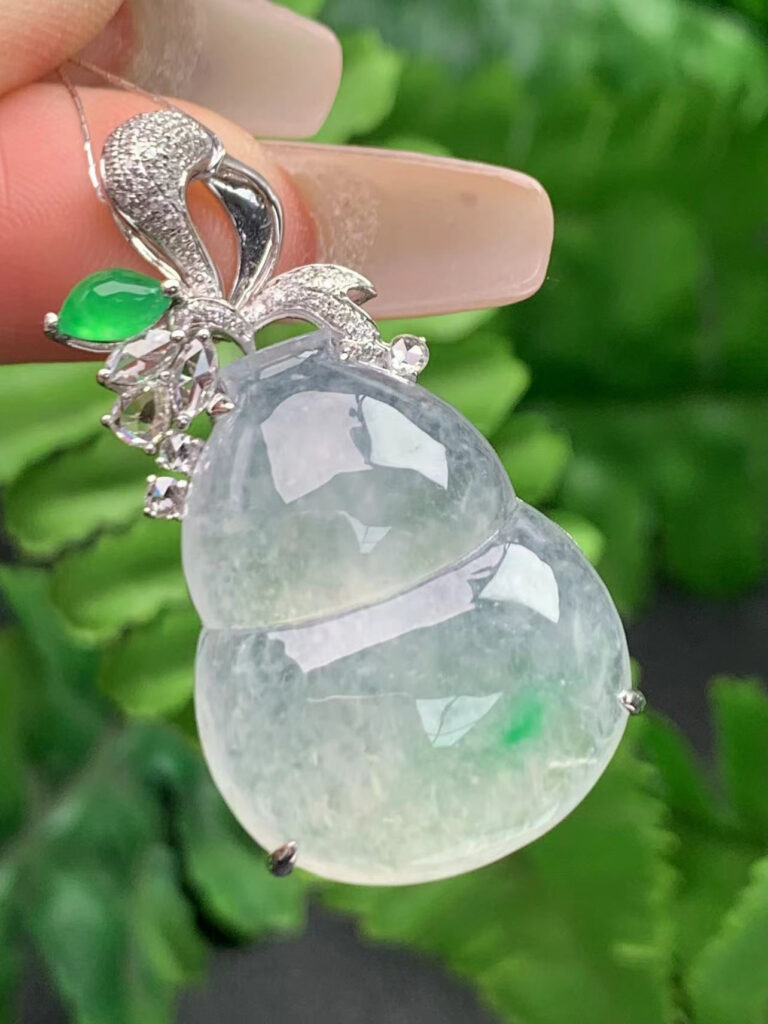Table of Contents

1. What Is Jadeite? A Precious Form of True Jade
The world of precious stones includes many gems admired for their beauty and rarity, and among them, this mineral known as jadeite holds a special place. Often regarded as a true form of jade, this gemstone distinguishes itself with unique physical properties and an array of captivating colors.
Unlike many other minerals, the jade variety referred to as this precious stone forms deep within the Earth’s crust under high pressure and temperature conditions. This process results in a dense and durable gemstone, characterized by a granular crystalline structure that contributes to its remarkable translucency and a smooth, lustrous finish. These qualities make it highly sought after for fine jewelry and ornamental carvings.
One of the most intriguing aspects of this gemstone is its wide range of colors, from the classic and vibrant greens to soft lavenders, milky whites, and rare shades of pink and blue. The vividness and clarity of these colors often define the stone’s value and desirability.
Beyond its physical allure, this jade variety carries deep cultural significance, particularly in East Asia, where it symbolizes purity, protection, and prosperity. Historically, it has been treasured not only for adornment but also as a talisman and heirloom passed down through generations.
Understanding this precious stone’s origins, characteristics, and cultural meaning allows collectors and enthusiasts alike to appreciate its enduring allure and significance.
2. Jadeite vs Nephrite: What Makes Them Different
Although often grouped together under the common name “jade,” this mineral and its counterpart, nephrite, are two distinct substances, each with their own unique properties. Recognizing these differences is crucial for anyone interested in authentic jade pieces.
Firstly, the chemical compositions vary significantly. This gemstone is primarily a sodium aluminum silicate, while nephrite consists mainly of calcium magnesium iron silicate. These compositional differences influence their respective appearances and physical characteristics.
In terms of texture, the jade variety described here features a granular, interlocking crystal structure that typically results in higher translucency and a glass-like sheen. In contrast, nephrite has a fibrous and dense texture, which makes it tougher but often less translucent.
Color variation is another distinguishing factor. The precious stone in question offers a wider and more vibrant palette, including intense greens, lavenders, and whites. Nephrite usually displays softer greens, creamy whites, and earthy browns, with fewer bright color options.
When it comes to hardness, both are durable, but nephrite is somewhat tougher due to its fibrous makeup, making it more resistant to breakage. This gemstone generally rates between 6.5 and 7 on the Mohs scale, whereas nephrite falls slightly lower.
Lastly, market value and rarity differ. High-quality specimens of this mineral, especially those with vivid colors and translucency, typically command premium prices. Nephrite, while respected and widely used, is generally more abundant and affordable.
By understanding these key differences, collectors and buyers can make informed choices and appreciate the unique qualities each jade variety offers.
3. The Origins of Jadeite: From Burma to the World
The story of this precious stone begins in a few select locations around the globe, where unique geological conditions have allowed it to form over millions of years. Among these, Burma (Myanmar) stands out as the most famous and historically significant source. The mountainous regions of northern Myanmar provide the perfect environment of high pressure and temperature, which enables the formation of some of the finest and most sought-after specimens.
Burmese jadeite has influenced cultures worldwide, particularly in East Asia, where it has been treasured for centuries as a symbol of beauty and spiritual significance. The quality of the jade variety mined here often sets the benchmark for the global market, especially for the highly prized “Imperial Green” shade.
Besides Myanmar, other sources of jadeite include Guatemala, where the stone holds important cultural value among indigenous peoples. Although the quality varies, Guatemalan jadeite contributes to the diversity of this gemstone on the market.
In Japan, the Itoigawa region produces jadeite, albeit in smaller quantities and generally less vibrant colors. Additionally, deposits in the Ural Mountains of Russia yield jadeite, though these stones tend to lack the intense hues found in Burmese jade.
While these sources differ in quantity and quality, the reputation of Burmese jadeite remains unrivaled. Its rich history and exceptional appearance continue to make it the world’s most coveted form of jade.

4. The Color Spectrum: Why “Imperial Green” Is So Valuable
One of the defining characteristics of this mineral is its incredible variety of colors. The palette ranges from soft pastels to vivid hues, each carrying its own unique charm and significance. However, among all these shades, the color known as “Imperial Green” stands supreme in terms of value and desirability.
Imperial Green is characterized by a vibrant, emerald-like green that is both rich and deeply saturated. This rare hue results from trace amounts of chromium within the stone’s structure, giving it an almost glowing appearance. What truly sets this color apart is not just its brightness but also its clarity and translucency, which create a stunning visual effect when light passes through the gemstone.
Other notable colors include lavender, a delicate purple that offers a softer and more feminine appeal; milky white, often called “mutton fat” jade, prized for its purity; and apple green, a lighter, fresher shade popular among many buyers.
Colors such as yellow, orange, red, and rare blues add to the diversity and appeal of this precious stone, each evoking different cultural meanings and personal preferences.
Despite the variety, Imperial Green continues to command the highest prices on the market. Its rarity and breathtaking beauty make it the ultimate goal for collectors and connoisseurs alike.
5. Types of Jadeite: From Glassy to Moss-in-Snow Patterns
Jadeite is admired not only for its color but also for the variety of textures and patterns that give each piece a unique character. Understanding these types can help collectors and buyers appreciate the stone’s diversity and select pieces that suit their tastes.
One of the most prized types is glassy jadeite, named for its high translucency and smooth, reflective surface. This variety often resembles polished glass, allowing light to penetrate deeply, which enhances its vibrant colors and lends an almost ethereal glow to the stone.
Another fascinating pattern is known as moss-in-snow jadeite. This type features green, moss-like inclusions that seem to float within a white or translucent background, resembling moss growing in a snowy landscape. Each piece is naturally unique, making it highly sought after for its artistic appeal.
Other common types include icy jadeite, which is extremely translucent with a cool, crystal-clear appearance, and oil-green jadeite, characterized by its rich, deep green color and slightly oily luster. Opaque jadeite offers a more solid, dense appearance with muted tones and is often favored for traditional carvings.
By recognizing these different types, buyers can better appreciate the natural beauty and complexity of this precious stone and make choices that reflect their individual style.
6. How to Identify Genuine Jadeite Before You Buy
As jadeite’s popularity continues to rise globally, distinguishing authentic pieces from imitations, treated stones, or synthetics becomes increasingly important. Whether you are a collector, investor, or casual buyer, understanding how to recognize genuine jadeite will protect your purchase and ensure lasting satisfaction. Here are several practical and reliable tips to help you identify authentic jadeite before making a purchase:
Examine the Surface Texture Carefully
Real jadeite has a unique tactile feel—it is typically smooth with a subtle waxy or oily texture. This is unlike glass or plastic imitations, which often feel colder, slicker, or artificial. When you gently rub the surface, authentic jadeite should feel cool yet slightly warm to the touch after a moment, indicating its natural mineral composition.
Observe the Translucency and Glow
One hallmark of high-quality jadeite is its ability to transmit light softly, producing a gentle inner glow. Hold the stone up to a light source; genuine jadeite will allow light to penetrate, creating a depth and luminosity that fakes often lack. Stones that appear fully opaque, dull, or flat are less likely to be authentic or of good quality.
Look for Natural Inclusions and Imperfections
Unlike synthetic or heavily treated stones, natural jadeite almost always contains small mineral inclusions or slight imperfections visible under magnification. These tiny internal features can include minute crystals or wisps that add character and authenticity. Beware of stones that are perfectly flawless, as they may be synthetic or artificially enhanced.
Perform a Scratch Test with Caution
Jadeite ranks between 6.5 and 7 on the Mohs hardness scale, meaning it is relatively hard and resistant to scratching by common materials like steel or glass. However, avoid performing scratch tests on valuable pieces yourself to prevent accidental damage. Instead, rely on professional gemological testing for hardness and durability confirmation.
Check for Color Uniformity and Natural Variation
Natural jadeite exhibits subtle variations in color intensity and tone across the stone, adding to its uniqueness. Artificially dyed jadeite may show unnatural, uneven color patches or overly bright hues that do not blend well. Examine the piece under different lighting to assess color consistency.
Request Certification from Reputable Labs
Certified gemstones come with documentation from respected gemological laboratories confirming their authenticity, origin, and whether they have undergone any treatments. Always ask for such certificates before purchasing, especially when buying high-value jadeite.
Use Professional Testing Instruments
Gemologists use tools like refractometers, spectroscopes, and microscopes to analyze optical and physical properties unique to jadeite. These tests help confirm the stone’s identity and detect treatments that may not be visible to the naked eye.
Buy from Trusted and Established Dealers
To minimize the risk of counterfeit or misrepresented jadeite, purchase only from reputable sellers with proven expertise and positive customer feedback. Established dealers provide transparent information and stand behind the authenticity of their products.
By applying these guidelines thoughtfully, you can confidently navigate the jadeite market, making purchases that are both beautiful and genuine. Careful evaluation and informed buying protect your investment and deepen your appreciation for this extraordinary gemstone.

7. Jadeite Jewelry: From Ancient Totems to Modern Luxury
Jadeite jewelry has a history that spans thousands of years, evolving from ancient symbolic artifacts to exquisite modern adornments. In early civilizations, this precious stone was often carved into totems, amulets, and ritual objects believed to hold protective and spiritual powers. These early pieces reflected deep cultural meanings and were treasured as sacred items.
As craftsmanship advanced, artisans began creating more intricate designs, incorporating the stone into necklaces, bracelets, rings, and earrings. Over time, jadeite jewelry became a symbol of status and refinement, prized not only for its beauty but also for its cultural significance.
In contemporary fashion, jadeite has firmly established itself as a luxury gemstone. Modern designers blend traditional motifs with innovative styles, producing pieces that appeal to a global audience. The gemstone’s timeless appeal, combined with its durability and vibrant colors, makes it a favorite choice for high-end jewelry collections.
From ancient totems to elegant luxury items, jadeite jewelry continues to captivate wearers and collectors alike, bridging history with modern aesthetics.
8. The Cultural Significance of Jadeite in Asian Traditions
Jadeite holds profound importance in many Asian cultures, where it is more than just a beautiful stone—it embodies spiritual and cultural values that have been passed down through generations.
In Chinese tradition, this gemstone symbolizes purity, harmony, and protection. It is often worn as a talisman to ward off evil and bring good fortune. The stone is deeply embedded in ceremonies, from weddings to ancestral worship, representing a connection to heritage and family.
Beyond China, jadeite is valued in countries like Japan, Korea, and Southeast Asia, each attributing unique meanings to the stone. For example, it is believed to promote health and longevity, serving as a bridge between the physical and spiritual worlds.
The use of jadeite in art, jewelry, and religious artifacts highlights its central role in cultural expression. Its enduring significance reflects a respect for nature, tradition, and the qualities of resilience and beauty.
This deep-rooted cultural reverence ensures that jadeite remains much more than a decorative gemstone; it is a symbol of identity and legacy in many Asian societies.

9. Investing in Jadeite: What You Need to Know
Investing in jadeite can be a rewarding venture, combining appreciation for natural beauty with potential financial growth. However, navigating the market requires a solid understanding of what determines the value and authenticity of this precious gemstone.
Quality is Paramount
The foremost factor influencing jadeite’s investment value is quality. Experts evaluate stones based on color, translucency, texture, and craftsmanship. The coveted “Imperial Green” jadeite, known for its vivid, emerald-like hue, coupled with excellent translucency and a smooth, fine texture, is rare and commands premium prices. Other colors like lavender and white can also be valuable, but their market appeal varies.
Authenticity and Certification
With the rise in popularity, the jade market has seen an increase in treated or synthetic stones. These typically lack long-term value compared to natural, untreated jadeite. Therefore, it is essential to acquire jadeite accompanied by certification from reputable gemological laboratories. These certificates verify the stone’s natural origin and disclose any treatments it has undergone.
Provenance Matters
The origin of jadeite can impact its value. Burmese jadeite, especially from northern Myanmar, is renowned worldwide for its superior quality and rarity. Historically significant deposits often produce the highest-grade stones, making provenance a crucial consideration for investors.
Market Dynamics and Trends
Like all investments, jadeite prices fluctuate based on market demand, cultural trends, and economic conditions. Interest from collectors, especially in Asia, has driven prices higher in recent years. Keeping abreast of market developments and working with trusted dealers can help investors make informed decisions.
Long-Term Perspective
Jadeite is generally considered a long-term investment. Unlike more volatile commodities, high-quality jadeite tends to appreciate steadily over time, especially rare colors and fine craftsmanship. It is also a tangible asset that combines cultural significance with aesthetic value.
Purchasing Tips
- Always buy from reputable sources with transparent policies.
- Inspect the stone in person if possible, paying attention to color consistency and texture.
- Consider the piece’s craftsmanship, especially if it’s a carved or mounted item.
- Keep documentation and certificates safe for future verification or resale.
Investing in this gemstone combines passion and prudence, offering both the joy of owning exquisite beauty and potential financial rewards.
10. How to Care for and Preserve Your Jadeite Treasures
To ensure your jadeite jewelry and artifacts maintain their beauty and value over the years, proper care and maintenance are essential. This precious stone, while durable, still requires gentle handling and mindful upkeep.
Cleaning Techniques
Use a soft, lint-free cloth with warm water and mild soap to clean your jadeite pieces. Avoid harsh chemicals, bleach, or abrasive cleaners that can damage the surface. Ultrasonic or steam cleaners are generally not recommended, as they may cause micro-fractures or affect any treatments.
Temperature and Sunlight
Protect jadeite from sudden temperature changes, which can cause cracking. Prolonged exposure to direct sunlight should also be avoided, as it may lead to color fading, especially in more delicate hues.
Storage Practices
Store your jadeite jewelry separately from other pieces to prevent scratches or abrasions. Soft pouches, padded jewelry boxes, or cloth-lined compartments are ideal. Avoid placing heavy objects on top of jadeite items.
Wear and Handling
Remove jadeite jewelry before engaging in physical activities such as sports, gardening, or heavy cleaning. Also, avoid contact with perfumes, hairsprays, lotions, or household chemicals that might harm the stone or metal settings.
Regular Inspection
Periodically check the settings, clasps, and surfaces for any signs of wear or damage. Loose stones or weakened mounts should be repaired promptly by a professional jeweler to prevent loss or further damage.
Professional Care
Consider having your jadeite pieces professionally cleaned and inspected every one to two years. Experts can safely remove dirt and oils and check for structural integrity.
Cultural Practices
In many cultures, wearing jadeite regularly is believed to enhance its energy and beauty. While this is a spiritual consideration, it also ensures the stone benefits from natural oils on the skin that can help maintain its luster.
By following these care guidelines, you can preserve the brilliance and integrity of your jadeite treasures, ensuring they remain radiant and valuable heirlooms for future generations.